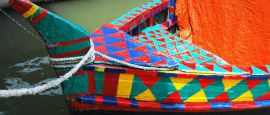The beating heart of the Bengali capital, Old Dhaka is a sprawl of crowded alleyways, unravelling onto the waterfront at Sadar Ghat. As well as famous monuments – Ahsan Manxzil, Lalbagh Fort – the streets are crammed with atmospheric markets selling every imaginable product, and on the edge of the old city is the Baitul Mukarram Mosque, the 10th biggest in the world.
Bangladesh things to see and do
Tourist offices
Address: 83-88 Mohakhali C/A, Dhaka, 1212, Bangladesh
Tel: (2) 9899 288.
www.parjatan.gov.bd/index5.php
The long sandy beaches of the far south are better known, but locals claim the finest stretch of sand is at Kuakata, a low-key resort on the edge of the Sundarbans. Close to Barisal, Kuakata offers sparkling sand, swaying palms, ramshackle seafood cafes, laid-back beach resorts, and few of the crowds who mob the sands at Cox’s Bazaar.
The archaeological sites of Paharpur, Mahasthanagarh and Sherpur, close to the town of Bogra in the country's northwest, reveal the ancient Hindu and Buddhist origins of Bangladesh. The Somapura Mahavihara was one of the most important Buddhist monasteries of the ancient world and the remains of its vast central stupa dominate the ruins at Paharpur.
About 25km (15 miles) southeast of Dhaka, sleepy Sonargaon offers respite from the chaos of the capital. This was the capital of eastern Bengal under a string of nawabs and sultans and their faded mansions still line the main road in the village of Painam Nagar. Nearby are ruined mosques and a fine folk-art museum in the historic Sadarbari villa.
With its crowds, bazaars and rickshaw traffic jams, Bangladesh’s capital is famously fast-paced and frenetic. The best place to feel the vibrations of the Bengali capital is Sadar Ghat, where passengers spill from boats day and night in a continuous human tide. More laid-back sights include the uncompleted 17th-century Lalbagh Fort and the stately Ahsan Manzil Palace and Museum.
One of Bangladesh’s most iconic experiences is the overnight boat trip on the Rocket – the nostalgic paddle-wheel ferry that has piled the waterways between Dhaka and Khulna for more than century. Today, boats travel only as far as Morelganj, but the trip is perhaps the most atmospheric way to experience the pace of life on Bengal’s waterways.
The southern beach resort of Cox’s Bazaar attracts local holiday makers in droves, but a more interesting experience can be had off-shore on Maheskali Island, a pilgrimage destination for Muslims, Hindus and Buddhists. Rickshaws wait at Kasturi Ghat to ferry new arrivals up the hill to the Hindu Adinath temple, which offers panoramic views of the island.
The divisional capital of Sylhet has grown wealthy from the money sent home by Bengalis working in the UK. Tea is the big local industry, and many workers in the tea plantations are tribal Manipuri and Khasi people. Some estates are within walking distance of the centre and the revered mausoleum of Hazrat Shah Jalal, a 14th-century Sufi mystic.
Sylhet Division, northeast of Dhaka, is known as 'the land of two leaves and a bud' because of its long tradition of growing fine Indian teas. The best-known estates are found close to the town of Srimangal, which sits amidst a sea of green tea bushes. Many estates offer tours and tastings of the flavoursome local brew.
The elusive Bengal tiger stalks the rain-soaked waterways of Sundarbans National Park, a vast area of estuarine forest sprawling out into the Bay of Bengal. Spilling over into India, this is the largest mangrove forest in the world, and boat trips offer glimpses of deer, monkeys, exotic birds, and for the lucky, the Bengal tiger himself.
In the southwest, near Khulna, the town of Bagerhat was the 15th-century capital of the warrior saint Khan Jahan Ali, and the countryside is dotted with the remains of his holy city. The 15th-century Shait Gumbad, the so-called 'Sixty-domed' Mosque, is the most well known structure, but there are more ancient mosques nearby, as well as the mausoleum of Jahan Ali.
In Bangladesh’s far south, close to the border with Myanmar, Cox’s Bazaar is where Bangladesh comes to unwind. The world's longest and broadest beach, Inani Beach sprawls south from the city, providing a favourite promenading spot for local holidaymakers. Foreign visitors use the city as a leaping off point for nearby St Martin’s Island, perhaps Bangladesh’s most perfect beach paradise.
Rangamati is the gateway to the Buddhist tribal villages of Kaptai Lake, whose culture owes more to neighbouring Myanmar than to the rest of Bangladesh.
Boats trips on Kaptai Lake visit Chakma villages and Myanmar-style pagodas, taking in the idyllic green scenery.
The second largest city in Bangladesh, Chittagong is ringed by coconut groves and sandy beaches. This is the gateway to the fascinating Chittagong Hill Tracts, home to Bangladesh’s Buddhist hill tribes, and the resort beaches of the far south, but there’s plenty to see in the city, including museums and 17th-century mosques.
Do you have any Feedback about this page?
© 2025 Columbus Travel Media Ltd. All rights reserved. No part of this site may be reproduced without our written permission, click here for information on Columbus Content Solutions.








 You know where
You know where